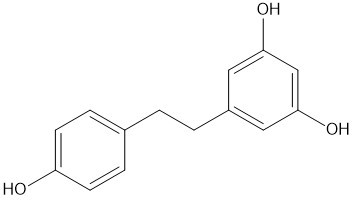Dihydroresveratrol | Resveratrol metabolite
NMR (Conforms)

Available Options
| Size: | Price | Quantity | |
|---|---|---|---|
| 5 Mg | $50.00 | ||
| 25 Mg | $170.00 |
Dihydroresveratrol (58436-28-5) is a metabolite of resveratrol produced by gut microbiota.1-3 Glucoronide conjugates are found in human urine after oral intake of resveratrol-containing dietary supplements.4 Dihydroresveratrol glucoside is a potent melanogenesis inhibitor in B16F0 melanoma cells.5 Inactive analog of resveratrol in induction of premature senescence.6
References/Citations:
1) Jung et al. (2009), Interaction of dietary resveratrol with animal-associated bacteria; FEMS Microbiol. Lett., 297 266
2) Bode et al. (2013), In vivo and in vitro metabolism of trans-resveratrol by human gut microbiota; Am. J. Clin. Nutr., 97 295
3) Jarosova et al. (2019), Metabolism of Stilbenoids by Human Faecal Microbiota; Molecules, 24 E1155
4) Radco et al. (2013), Semi-preparative isolation of dihydroresveratrol-3-O-ß-d-glucuronide and four resveratrol conjugates from human urine after oral intake of a resveratrol-containing dietary supplement; J. Chromatogr. B Analyt. Technol. Biomed. Life Sci., 930 54
5) Oode et al. (2014), Synthesis of dihydroresveratrol glycosides and evaluation of their activity against melanogenesis in B16F0 melanoma cells; Eur. J. Med. Chem., 87 862
6) Faragher et al. (2011), Resveratrol, but not dihydroresveratrol, induces premature senescence in primary human fibroblasts; Age (Dordr.), 33 555
NMR (Conforms)
Safety Data Sheet:
Product Data Sheet:
Materials provided by Focus Biomolecules are for laboratory research use only and are not intended for human or veterinary applications. Please note that we do not sell to individuals and that all orders placed by non-research organizations will incur a $20 restocking/refund fee
Dihydroresveratrol (58436-28-5) is a metabolite of resveratrol produced by gut microbiota.1-3 Glucoronide conjugates are found in human urine after oral intake of resveratrol-containing dietary supplements.4 Dihydroresveratrol glucoside is a potent melanogenesis inhibitor in B16F0 melanoma cells.5 Inactive analog of resveratrol in induction of premature senescence.6
References/Citations:
1) Jung et al. (2009), Interaction of dietary resveratrol with animal-associated bacteria; FEMS Microbiol. Lett., 297 266
2) Bode et al. (2013), In vivo and in vitro metabolism of trans-resveratrol by human gut microbiota; Am. J. Clin. Nutr., 97 295
3) Jarosova et al. (2019), Metabolism of Stilbenoids by Human Faecal Microbiota; Molecules, 24 E1155
4) Radco et al. (2013), Semi-preparative isolation of dihydroresveratrol-3-O-ß-d-glucuronide and four resveratrol conjugates from human urine after oral intake of a resveratrol-containing dietary supplement; J. Chromatogr. B Analyt. Technol. Biomed. Life Sci., 930 54
5) Oode et al. (2014), Synthesis of dihydroresveratrol glycosides and evaluation of their activity against melanogenesis in B16F0 melanoma cells; Eur. J. Med. Chem., 87 862
6) Faragher et al. (2011), Resveratrol, but not dihydroresveratrol, induces premature senescence in primary human fibroblasts; Age (Dordr.), 33 555
Calculate the molar concentration, mass or volume in a solution.
Concentration × Volume × Molecular Weight = Mass
Focus Biomolecules • Plymouth Meeting, PA USA • 1-855-FOCUS21
Focus Biomolecules
Plymouth Meeting, PA USA
1-855-FOCUS21
Website Created by Advanta Advertising LLC.

